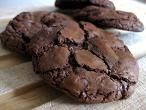
Catering for the Passover meal involves more than just the food. It's also making sure that all the ritual extras of the Passover meal are present. The main part of this involves the seder plate, which contains most of the symbolic food items referred to during the story-telling part of the evening. It includes: a burnt egg and a shank bone (we had a veggie alternative hand-crafted from a carrot) which symbolise the offerings made in the temple; some bitter herbs and radish for the bitterness of slavery; another vegetable (traditionally parsley in our family) which is dipped into salt water and eaten to remember the salty tears of the Jewish slaves; and charoset, which is a mixture of nuts, apples and cinnamon and represents the mortar the slaves had to use in their
 building work for the Pharaohs. (The word in the middle of our plate says 'Pesach' in Hebrew). There are also three sheets of matzah kept in a cloth cover for use at several points. The evening is ordered (the word seder actually means 'order') by a series of prayers, stories and symbolic rituals like the dipping of the parsley in salt water, drinking four cups of wine at various points and some songs, including one sung by the youngest person present, who will have rehearsed for weeks, and be nervously awaiting their star role. We had no children present this year, so the task fell to Eco Sis, who performed very well.
building work for the Pharaohs. (The word in the middle of our plate says 'Pesach' in Hebrew). There are also three sheets of matzah kept in a cloth cover for use at several points. The evening is ordered (the word seder actually means 'order') by a series of prayers, stories and symbolic rituals like the dipping of the parsley in salt water, drinking four cups of wine at various points and some songs, including one sung by the youngest person present, who will have rehearsed for weeks, and be nervously awaiting their star role. We had no children present this year, so the task fell to Eco Sis, who performed very well.All these rituals no doubt seem very confusing (as the Ecos' housemate will no doubt agree!), but they are an integral part of why I loved seder nights as a child, and are rich in the symbolism of centuries of dark events and happy recollections in Jewish history. It all takes a really long time - Munchkin Granny had only got home at 3am the night before from the first-night seder at her brother's, and continues after the meal with more story and singing. Then, of course, there are the extra rituals which individual families bring to the mix, or traditions from different cultures. One of these was the spring onion whipping which Eco Sis had introduced us to a few years ago, but Jews from the Middle East have a whole range of customs we don't have, including dressing up as the Jews fleeing Egypt. There are loads more, but they'd just make this post far too long. We do a 'best of' version which is a little curtailed!
 Eco Sis's spring onion after a vigorous bout of recalling past slavery
Eco Sis's spring onion after a vigorous bout of recalling past slaveryThe main part of the story-telling happens before dinner, so you work up a nice appetite, especially with all that whipping. We always start with hard boiled eggs in salt water, symbolising the roundness of renewal and spring, plus the saltiness of the slaves' tears. Then Eco Sis had made peanut soup which everyone else loved, but which I sat out due to the old nut phobia. Then she'd made a baked aubergine dish which was lovely, and her guests had brought some amazing salads. And finally, the desserts: the cinnamon balls, the Turkish delight, and the main one: a chestnut, chocolate and orange mousse cake. Eco Sis is a big fan of chocolate mousse, and I'd made it with her in mind. The original recipe was a gluten-free one for a slice, but I made it in a round cake pan so that it would look more elegant as a dinner party dessert. Eco Sis was so keen to try it that she could barely wait for the photography to take place, but it got an undoubted thumbs up. And the best part was that it's really easy to make - just some stirring, melting and chilling. I'll definitely be making it again. I've only started using chestnut puree in desserts in the last year but I've got three good recipes now, including one of The Scientist's all time favourites - Nigella's jewelled Christmas cupcakes from Feast. In fact, that's what the rest of the tin of puree is destined to become later this week, so I may post about that later. Is it incongruous to use half a tin for a Passover dessert and the other half for a Christmas one - both eaten by The Scientist, who is completely a-religious?

Chestnut orange chocolate mousse cake (from recipes4us.co.uk)
(Gluten and wheat free)
Ingredients
225 g unsweetened chestnut puree
175g caster sugar
175g butter
250g plain chocolate (the recipe notes that you should check it's gluten free if that's an issue)
The finely grated rind and juice of one orange
Whipped cream, to serve (I didn't bother with this as we had so much else!)
Grease and line your choice of tin - I used a round 23 inch cake tin; the original recipe suggests a Swiss roll tin if you're going to serve it as a slice.
In a large mixing bowl, beat the puree until soft. Set aside
In another bowl beat together the butter and sugar until pale and fluffy. Set aside.
Break up the chocolate and melt in the microwave or over hot water.
Add the melted chocolate and chestnut puree to a creamed butter and sugar together with the orange rind and juice. Beat until well blended.
Spread the mixture in the prepared tin and refrigerate for 8 hours until set.
Go face down in your serving and feel happy if you're Eco Sis.



3 comments:
more interesting information and great recipe and sounds like you had fun - I must try this cake as have a tin of chestnut puree in my cupboard, I think! And I love your carrot bone!
Oooh yes, give it a try - it's lovely - and don't you have gluten free family? I'd be interested to know if it's to children's tastes - very rich!
I'm getting an education! Sounds like you are having a wonderful week filled with family, friends and good food!
Very interesting mousse recipe, I love that it contains chestnut puree. Orange and chocolate, yum!
Post a Comment